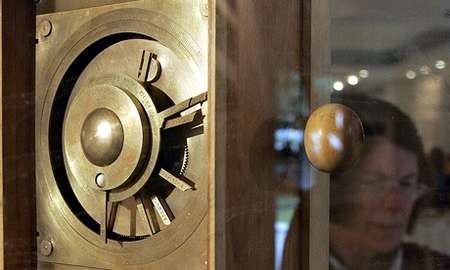Revolutionary diving suit to be used at site of 'world's oldest computer' find
Exosuit will enable divers to reach double normal depths during return expedition to wreck that yielded Antikythera mechanism
Agence France-Presse in Athens
theguardian.com, Monday 15 September 2014

Photograph: A reconstruction of Antikythera mechanism. Photograph: Louisa Gouliamaki/AFP/Getty Images
Archaeologists began using a revolutionary new deep-sea diving suit on Monday to explore the ancient shipwreck where one of the most remarkable scientific objects of antiquity was found.
The Antikythera mechanism – a 2nd-century BC device known as the world's oldest computer – was discovered by sponge divers at the turn of the 20th century off a remote island in the Aegean.
The complex device of up to 40 bronze cogs and gears was used by the ancient Greeks to track the cycles of the solar system. It took another 1,500 years for an astrological clock of similar sophistication to be made in Europe.
Returning to the wreck, archaeologists will be using a new diving suit that enables them to dive to more than double the depth they can usually go, and stay safely at the bottom for longer.
The Exosuit, built in Canada by Nuytco Research, will allow divers to reach depths of 150 metres (492ft) and still perform delicate tasks, says the archaeologist Theotokis Theodoulou.
The suit, which resembles a puffy space suit, "expands our capabilities", he told AFP as the research team set off for a month-long expedition to Antikythera, which lies between Crete and the Peloponnese.
"I'll be able to grasp, pluck, clench and dig … for several hours," he added.
Archaeologists believe many other artefacts are yet to be discovered in and around the wreck. Up to now they have only been able to operate at a depth of 60 metres.
The Antikythera mechanism was found along with a spectacular bronze statue of a youth in the wreck of a cargo ship apparently carrying booty to Rome.
"We have good signs that there are other objects present," said Angeliki Simosi, the head of Greece's directorate of underwater antiquities, after exploratory dives in the area in 2012 and 2013.
"There are dozens of items left, this was a ship bearing immense riches from Asia Minor," added Dimitris Kourkoumelis, another archaeologist on the team.
The archaeologists also hope to confirm the presence of a second ship, though to be lying about 250 metres away from the original discovery site.
Antikythera, which now has a population of only 44, was on one of antiquity's busiest trade routes, and a base for Cilician pirates, some of whom once captured and held the young Julius Caesar for ransom. He later had them all captured and crucified.
The Greek team is being assisted by Brendan Foley, a marine archaeologist from the Woods Hole Oceanographic Institution at Massachusetts in the US, which was involved in a dive to the wreck of the Titanic. He has helped with outings to identify ancient shipwrecks over the past five years.
"We may find one or more monumental statues that were left behind in 1901, in the mistaken belief that they were rocks," Foley said.
As well as the Exosuit, the Antikythera expedition will also use robot mapping equipment and new advanced closed-circuit "rebreathers", which will allow divers much more time underwater.
"We will have more bottom time than any previous human visitors to the site, because we dive with mixed gas rebreathers," the expedition's website says.
"Each diver will have more than 30 minutes of bottom time per day, and will enjoy greater mental acuity and a larger safety margin than that of previous divers at Antikythera."